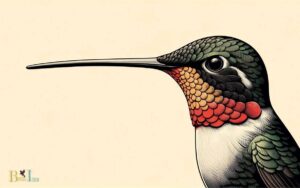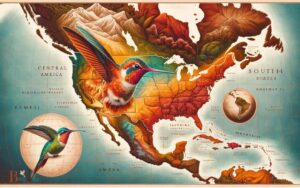Do Anna’s Hummingbirds Migrate? Yes!
Yes, Anna’s Hummingbirds do migrate, but their migratory patterns are somewhat atypical. Unlike many migratory bird species, Anna’s Hummingbirds do not migrate long distances.
Instead, some populations exhibit a form of migration known as “altitudinal migration,” where birds move from higher elevations to lower ones during colder months.
Anna’s Hummingbirds (Calypte anna) are native to the West Coast of North America. Their range extends from southern Canada, down through the United States, to Baja California in Mexico.
Traditionally, they were seasonal migrants, moving to warmer regions during the winter.
However, with changes in climate and the availability of food resources like backyard feeders, many Anna’s Hummingbirds are now year-round residents in parts of their range, particularly along the Pacific Coast.
These hummingbirds may migrate in the following ways:
It’s important to note that the migratory behavior of Anna’s Hummingbirds can vary greatly based on regional conditions and individual bird behavior.
With a flash of iridescent feathers, Anna’s Hummingbirds bring dynamic beauty to their habitats, adapting their migratory habits to the changing climates they face.

Key Takeaway
Anna’s Hummingbird Overview
Anna’s hummingbirds are primarily found in the western coastal regions of North America. These tiny birds, with metallic green plumage and iridescent rose-pink throats on the males, are a common sight in gardens, woodlands, and coastal scrub.
They are known for their remarkable agility and speed, capable of intricate aerial maneuvers. Anna’s hummingbirds are non-migratory, unlike many other hummingbird species.
They have adapted to the milder climates of their habitat, allowing them to stay year-round in their territories. Their diet primarily consists of flower nectar, supplemented with small insects and spiders for protein.
These birds are known for their distinctive vocalizations, producing a series of high-pitched, squeaky chirps and whistles.
Understanding their behavior, habitat, and unique characteristics is crucial for their conservation and protection.
Natural Habitat of Anna’s Hummingbirds
Anna’s Hummingbirds are known for their year-round coastal habitats along the western coast of North America, from southern Canada to northern Baja California, Mexico.
These habitats often consist of diverse plant ecosystems, including chaparral, coastal sage scrub, and urban gardens, providing an abundant source of nectar for these small birds.
The varied and plentiful vegetation found within their natural habitat allows Anna’s Hummingbirds to thrive and adapt to different environmental conditions.
Year-Round Coastal Habitats
Year-round coastal habitats provide the natural habitat for Anna’s hummingbirds. These habitats offer a diverse range of flowering plants, including coastal sage, buckwheat, and various native shrubs, which are essential food sources for Anna’s hummingbirds.
The mild coastal climate also ensures a steady supply of nectar throughout the year, crucial for the survival of these birds.
- The interconnected web of life in these coastal habitats demonstrates the delicate balance that supports the existence of Anna’s hummingbirds.
- It’s awe-inspiring to witness how these tiny creatures have adapted to thrive in such unique and beautiful coastal ecosystems, showcasing the resilience and wonder of nature.
These points serve to highlight the critical importance of preserving these coastal habitats for the continued well-being of Anna’s hummingbirds.
Diverse Plant Ecosystems
Amidst the year-round coastal habitats, the diverse plant ecosystems play a crucial role in providing essential food sources and nectar for Anna’s hummingbirds.
These ecosystems encompass a variety of flowering plants, including but not limited to, sage, penstemon, and tree mallow, which are well-suited to the hummingbird’s foraging needs.
The sage plant (Salvia sp.) produces tubular red, pink, or purple flowers that are rich in nectar, serving as a vital food source for the Anna’s hummingbird.
Similarly, penstemon and tree mallow produce tubular flowers that provide a consistent nectar supply.
These diverse plant ecosystems not only offer sustenance but also provide suitable nesting sites and protective cover for the hummingbirds.
This intricate network of flora within the coastal habitats ensures a sustainable environment for the Anna’s hummingbird population.
Breeding Behavior and Nesting
During the breeding season, Anna’s Hummingbirds exhibit distinct nesting behaviors that are vital to their reproductive success.
These tiny birds engage in the following nesting behaviors:
- Meticulous nest construction: Anna’s Hummingbirds construct their nests using plant fibers, down, and spider silk, creating a strong and secure structure.
- Emotional impact: The dedication and precision with which these birds build their nests evoke a sense of admiration and awe, highlighting their commitment to ensuring the safety of their offspring.
- Aggressive defense of territory: These hummingbirds fiercely defend their nesting territories, displaying remarkable courage and determination to protect their young.
- Emotional impact: Witnessing the unwavering dedication of these birds to safeguard their offspring can evoke feelings of respect and empathy, underscoring the intensity of their parental instincts.
Food Sources and Feeding Habits
Throughout their territory, Anna’s Hummingbirds diligently seek out nectar from a variety of flowers, supplementing their diet with small insects and spiders for essential protein.
Their long, slender bills and specialized tongues allow them to access nectar from deep within flowers.
They are particularly drawn to red or orange tubular flowers such as penstemon, columbine, and red-flowering currant.
Anna’s Hummingbirds are also known to visit feeders filled with sugar water, especially during the winter months when natural nectar sources may be scarce.
Their rapid metabolism requires them to feed every 10-15 minutes, consuming up to half their body weight in food each day. This diverse diet provides the energy and nutrients needed for their active lifestyle.
As we delve into their feeding habits, it becomes evident that their dietary requirements are closely linked to their migratory behavior.
The Mystery of Migration
The migration patterns of Anna’s Hummingbirds have long intrigued researchers, prompting investigations into the environmental cues that trigger their movements.
Understanding the factors that drive their migration, such as changes in day length and food availability, is crucial for comprehending the survival challenges these birds face during their journeys.
Research also suggests that migration may have significant impacts on the overall population dynamics and genetic diversity of Anna’s Hummingbirds.
Anna’s Hummingbird Migration
Anna’s hummingbirds exhibit a remarkable migratory behavior that continues to intrigue scientists and bird enthusiasts alike.
These tiny birds embark on impressive journeys, covering hundreds of miles during their migration.
The mystery of Anna’s hummingbird migration evokes a sense of wonder and amazement in the audience, as they consider the following points:
- The resilience and determination of these small creatures as they navigate challenging landscapes and weather conditions.
- The beauty and grace of their flight, which captivates observers and ignites a sense of admiration for these remarkable birds.
- The perilous nature of their journey, highlighting the fragility of life and the importance of preserving their habitats.
- The interconnectedness of ecosystems, emphasizing the need for conservation efforts to protect these incredible migratory creatures.
Environmental Cues for Migration
Environmental cues play a crucial role in guiding the migratory behavior of Anna’s hummingbirds, serving as essential triggers for their remarkable journeys.
These cues primarily revolve around changes in day length, food availability, and environmental conditions.
As the days grow shorter and food sources dwindle with the onset of winter, Anna’s hummingbirds instinctively prepare for migration.
The decreasing daylight hours stimulate physiological changes, such as increased fat storage and hormonal shifts, prompting the birds to begin their journey.
Additionally, environmental factors like temperature and weather patterns influence their departure.
Research suggests that these cues are ingrained in the hummingbird’s genetic makeup, allowing them to sense and respond to environmental changes with remarkable precision.
Understanding these environmental cues is crucial for conservation efforts and enhancing our knowledge of the intriguing phenomenon of bird migration.
Migration Impact on Survival
Migration plays a critical role in the survival of Anna’s hummingbirds, contributing to their ability to thrive in diverse habitats and ecological conditions.
The mystery of migration evokes a sense of wonder and admiration, as these tiny birds embark on incredible journeys, facing numerous challenges along the way.
Consider the following emotional responses:
- Awe: The sheer determination and resilience displayed by these birds during their migration is awe-inspiring, leaving us in admiration of their ability to overcome obstacles.
- Fascination: The intricacies of how Anna’s hummingbirds navigate their migration routes and adapt to varying environments fascinate and captivate our imagination, underscoring the mystery and beauty of their journeys.
Understanding the impact of migration on the survival of Anna’s hummingbirds allows us to appreciate the vital role it plays in their existence and underscores the significance of preserving their migratory pathways.
Research Findings on Migration
Recent studies have demonstrated that a significant portion of Anna’s hummingbirds undertake a seasonal migration.
Research findings have revealed that a substantial number of Anna’s hummingbirds from northern regions, such as Canada and the northern United States, migrate to more temperate climates in the winter months, including coastal regions of the southern United States and Mexico.
This migration behavior is thought to be influenced by factors such as food availability and temperature.
Tracking studies using geolocators and banding efforts have provided valuable insights into the specific migratory routes and wintering grounds of these hummingbirds.
Moreover, genetic analyses have indicated distinct populations within the species, further supporting the notion of migratory behavior.
Understanding the patterns and drivers of migration in Anna’s hummingbirds is crucial for their conservation and management. This leads us to explore the factors affecting migration.
Factors Affecting Migration
During the migration period, Anna’s hummingbirds are influenced by various environmental factors that dictate their seasonal movements.
These factors include:
- Climate: Sudden changes in temperature or weather patterns can impact the availability of food sources, prompting hummingbirds to migrate to more favorable areas.
- Emotional Impact: Witnessing the resilience of these tiny creatures as they adapt to changing climates can evoke a sense of awe and admiration for their survival instincts.
- Resource Availability: The availability of nectar, insects, and suitable nesting sites plays a crucial role in determining the hummingbirds’ migratory patterns.
- Emotional Impact: Understanding the delicate balance between resource availability and the hummingbirds’ survival can evoke a sense of responsibility in preserving their habitats.
Non-Migratory Behavior in Some Regions
In certain regions, Anna’s Hummingbirds exhibit non-migratory behavior, remaining in their habitats year-round despite environmental fluctuations.
This behavior is often observed in areas with mild climates, abundant food sources, and suitable nesting sites.
Non-migratory Anna’s Hummingbirds may establish territories and defend them vigorously throughout the year.
The availability of nectar-producing flowers, insects, and suitable nesting materials are crucial factors influencing their decision to remain resident.
Additionally, in urban and suburban environments, where supplemental food sources such as hummingbird feeders are prevalent, these birds may choose to forgo migration.
Understanding the factors contributing to non-migratory behavior in Anna’s Hummingbirds is essential for conservation efforts and managing their populations in various habitats.
Conservation Efforts and Future Studies
Understanding the factors contributing to non-migratory behavior in Anna’s Hummingbirds is crucial for conservation efforts and future studies, as it allows for targeted interventions to protect their habitats and sustain their populations over time.
Conservation efforts and future studies are essential to ensure the survival of this species.
Conservation Efforts:
- Implementing habitat protection measures to safeguard their nesting areas.
- Collaborating with local communities to promote sustainable landscaping practices that support hummingbird populations.
Conclusion
The migration patterns of Anna’s hummingbirds remain a fascinating and enigmatic aspect of their behavior. Despite extensive research, the precise factors influencing their migration continue to elude scientists.
The conservation of their natural habitats and further studies on their migration patterns are crucial for the preservation of this remarkable species.
The mystery of their migration continues to captivate and inspire researchers, offering a reminder of the complexity and wonder of the natural world.






